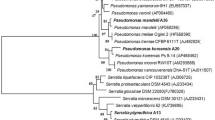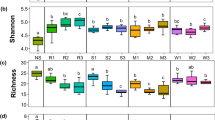Abstract
Dry tubers of Pinellia ternata (Thunb.) Breit are used in traditional Chinese medicine. Commonly known as “banxia” in China, the tubers contain valuable compounds, including alkaloids and polysaccharides that are widely used in pharmaceuticals. The quantity and quality of these important compounds are affected by whether P. ternata is grown as a sole crop or as an intercrop, and P. ternata cultivation has become challenging in recent years. By intercropping P. ternata, its maximum yield, as well as large numbers of chemical components, can be realized. Here, a large data set derived from next-generation sequencing was used to compare changes in the bacterial communities in rhizosphere soils of P. ternata and maize grown as sole crops and as intercrops. The overall microbial population in the rhizosphere of intercropped P. ternata was significantly larger than that of sole-cropped P. ternata, whereas the numbers of distinct microbial genera, ranging from 552 to 559 among treatments, were not significantly different between the two rhizospheres. The relative abundances of the genera differed. Specifically, the numbers of Acidobacteria and Anaerolineaceae species were significantly greater, and those of Bacillus were significantly lower, in the intercropped P. ternata rhizosphere than in the sole-cropped rhizosphere.






Similar content being viewed by others
References
Berendsen RL, Pieterse CMJ, Bakker PAHM (2012) The rhizosphere microbiome and plant health. Trends Plant Sci 17:478–486
Bernard E, Larkin RP, Tavantzis S et al (2012) Compost, rapeseed rotation, and biocontrol agents significantly impact soil microbial communities in organic and conventional potato production systems. Appl Soil Ecol 52:29–41
Chen L-H, Huang X-Q, Zhang F-G et al (2012) Application of Trichoderma harzianum SQR-T037 bio-organic fertiliser significantly controls Fusarium wilt and affects the microbial communities of continuously cropped soil of cucumber. J Sci Food Agric 92:2465–2470
Dang K, Gong X, Zhao G et al (2020) Intercropping alters the soil microbial diversity and community to facilitate nitrogen assimilation: a potential mechanism for increasing proso millet grain yield. Front Microbiol 11:2975
Dariush M, Ahad M, Meysam O (2006) Assessing the land equivalent ratio (LER) of two corn [Zea mays L.] varieties intercropping at various nitrogen levels in Karaj. Iran J Cen Europ Agri 7:359–364
del González-Chávez MCA, Aitkenhead-Peterson JA, Gentry TJ et al (2010) Soil microbial community, C, N, and P responses to long-term tillage and crop rotation. Soil Tillage Res 106:285–293
Eichorst SA, Kuske CR, Schmidt TM (2011) Influence of plant polymers on the distribution and cultivation of bacteria in the phylum acidobacteria. Appl Environ Microbiol 77:586–596
Gams W (2007) Biodiversity of soil-inhabiting fungi. Biodivers Conserv 16:69–72
Gombodorj S, Yang MH, Shang ZC et al (2017) New phenalenone derivatives from Pinellia ternata tubers derived Aspergillus sp. Fitoterapia 120:72–78
Hakim S, Naqqash T, Nawaz MS et al (2021) rhizosphere engineering with plant growth-promoting microorganisms for agriculture and ecological sustainability. Front Sustain Food Syst 5:16
He Z, Mao R, Dong JE et al (2019) Remediation of deterioration in microbial structure in continuous Pinellia ternata cropping soil by crop rotation. Can J Microbiol 65:282–295
Ho Y-N, Mathew DC, Huang C-C (2017) Plant-microbe ecology: interactions of plants and symbiotic microbial communities. Plant Ecology-Traditional Approaches to Recent Trends. InTech, pp 93–119
Iwasa M, Iwasaki T, Ono T, Miyazawa M (2014) Chemical composition and major odor-active compounds of essential oil from PINELLIA TUBER (dried rhizome of Pinellia ternata) as crude drug. J Oleo Sci 63:127–135
Jacoby R, Peukert M, Succurro A et al (2017) The role of soil microorganisms in plant mineral nutrition—current knowledge and future directions. Front Plant Sci 8:1617
Ji X, Huang B, Wang G, Zhang C (2014) The ethnobotanical, phytochemical and pharmacological profile of the genus Pinellia. Fitoterapia 93:1–17
Juneidi S, Gao Z, Yin H et al (2020) Breaking the summer dormancy of Pinellia ternata by introducing a heat tolerance receptor-like kinase ERECTA gene. Front Plant Sci 11:780
Kennedy AC, Smith KL (1995) Soil microbial diversity and the sustainability of agricultural soils. Plant Soil 170:75–86
Kim Y-G, Komakech R, Choi JE et al (2020) Mass production of Pinellia ternata multiple egg-shaped micro-tubers (MESMT) through optimized growth conditions for use in ethnomedicine. Plant Cell, Tissue Organ Cult 140:173–184
Larkin RP, Honeycutt CW, Olanya OM et al (2012) Impacts of crop rotation and irrigation on soilborne diseases and soil microbial communities. Sustainable Potato Production: Global Case Studies. Springer, Dordrecht, pp 23–41
Lauber CL, Hamady M, Knight R, Fierer N (2009) Pyrosequencing-Based assessment of soil pH as a predictor of soil bacterial community structure at the continental scale. Appl Environ Microbiol 75:5111–5120
Li X, Ding C, Zhang T, Wang X (2014) Fungal pathogen accumulation at the expense of plant-beneficial fungi as a consequence of consecutive peanut monoculturing. Soil Biol Biochem 72:11–18
Lin S, Nie B, Yao G et al (2019) Pinellia ternata (Thunb.) makino preparation promotes sleep by increasing REM sleep. Nat Prod Res 33:3326–3329
Liu X, Zhang J, Gu T et al (2014) Microbial community diversities and taxa abundances in soils along a seven-year gradient of potato monoculture using high throughput pyrosequencing approach. PLoS One 9:e86610
Luo S, Yu L, Liu Y et al (2016) Effects of reduced nitrogen input on productivity and N2O emissions in a sugarcane/soybean intercropping system. Eur J Agron 81:78–85
Ma G, Zhang M, Xu J et al (2020) Transcriptomic analysis of short-term heat stress response in Pinellia ternata provided novel insights into the improved thermotolerance by spermidine and melatonin. Ecotoxicol Environ Saf 202:110877
Mazzola M (2004) Assessment and management of soil microbial community structure for disease suppression. Annu Rev Phytopathol 42:35–59
McSpadden Gardener BB (2004) Ecology of Bacillus and Paenibacillus spp. in agricultural systems. Phytopathology 94:1252–1258
Moon BC, Kim WJ, Ji Y et al (2016) Molecular identification of the traditional herbal medicines, Arisaematis Rhizoma and Pinelliae Tuber, and common adulterants via universal DNA barcode sequences. Genet Mol Res 15:1–14
Rastogi G, Sani RK (2011) Molecular techniques to assess microbial community structure, function, and dynamics in the environment. Microbes and Microbial Technology. Springer, New York, pp 29–57
Van Der Heijden MGA, Bardgett RD, Van Straalen NM (2008) The unseen majority: soil microbes as drivers of plant diversity and productivity in terrestrial ecosystems. Ecol Lett 11:296–310
Vargas Gil S, Meriles J, Conforto C et al (2009) Field assessment of soil biological and chemical quality in response to crop management practices. World J Microbiol Biotechnol 25:439–448
Weinert N, Piceno Y, Ding GC et al (2011) PhyloChip hybridization uncovered an enormous bacterial diversity in the rhizosphere of different potato cultivars: Many common and few cultivar-dependent taxa. FEMS Microbiol Ecol 75:497–506
Welbaum GE, Sturz AV, Dong Z, Nowak J (2004) Managing soil microorganisms to improve productivity of agro-ecosystems. CRC Crit Rev Plant Sci 23:175–193
Xiong W, Li Z, Liu H et al (2015) The effect of long-term continuous cropping of black pepper on soil bacterial communities as determined by 454 pyrosequencing. PLoS One 10:e0136946
Xu JY, Dai C, Shan JJ et al (2018) Determination of the effect of Pinellia ternata (Thunb.) Breit. on nervous system development by proteomics. J Ethnopharmacol 213:221–22
Xu Y, Wang T, Li H et al (2019) Variations of soil nitrogen-fixing microorganism communities and nitrogen fractions in a Robinia pseudoacacia chronosequence on the Loess Plateau of China. CATENA 174:316–323
Xue T, Zhang H, Zhang Y et al (2019) Full-length transcriptome analysis of shade-induced promotion of tuber production in Pinellia ternata. BMC Plant Biol 19:565
Zamioudis C, Pieterse CMJ (2012) Modulation of host immunity by beneficial microbes. Mol Plant-Microbe Interact 25:139–150
Zhang JY, Guo QS, Zheng DS (2013) Genetic diversity analysis of Pinellia ternata based on SRAP and TRAP markers. Biochem Syst Ecol 50:258–265
Zhang X, Cai Y, Wang L et al (2015) Optimization of processing technology of Rhizoma Pinelliae Praeparatum and its anti-tumor effect. Afr Health Sci 15:101–106
Zhang GH, Jiang NH, Song WL et al (2016) De novo sequencing and transcriptome analysis of Pinellia ternata identify the candidate genes involved in the biosynthesis of benzoic acid and ephedrine. Front Plant Sci 7:1–14
Zhang Y, Li Q, Chen Y et al (2019) Dynamic change in enzyme activity and bacterial community with long-term rice cultivation in mudflats. Curr Microbiol 76:361–369
Zhang H, Zhang Z, Xiong Y et al (2021) Stearic acid desaturase gene negatively regulates the thermotolerance of Pinellia ternata by modifying the saturated levels of fatty acids. Ind Crops Prod 166:113490
Zhao J, Ni T, Li Y et al (2014) Responses of bacterial communities in arable soils in a rice-wheat cropping system to different fertilizer regimes and sampling times. PLoS One 9:e85301
Zi H, Jiang Y, Cheng X et al (2020) Change of rhizospheric bacterial community of the ancient wild tea along elevational gradients in Ailao mountain, China. Sci Rep 10:1–11
Funding
This work was supported by the National Key Research and Development Project of China [No.2017YFC1700700].
Author information
Authors and Affiliations
Contributions
HAN, ZZ, and SS designed the study; HAN wrote the MS; HAN, AHK, UA, MH, MA, and MMA helped create diagrams; HAN, MZ, UA, HB, AHK, MH, MMA, MH, and SS revised the MS; SS supervised All the authors have read and agreed to the published version of the manuscript.
Corresponding author
Ethics declarations
Conflict of interest
On behalf of all authors, the corresponding author states that there is no conflict of interest.
Supplementary Information
Below is the link to the electronic supplementary material.
Rights and permissions
About this article
Cite this article
Noushahi, H.A., Zhu, Z., Khan, A.H. et al. Rhizosphere microbial diversity in rhizosphere of Pinellia ternata intercropped with maize. 3 Biotech 11, 469 (2021). https://doi.org/10.1007/s13205-021-03011-3
Received:
Accepted:
Published:
DOI: https://doi.org/10.1007/s13205-021-03011-3




